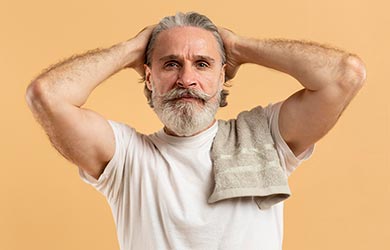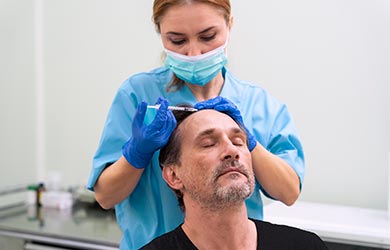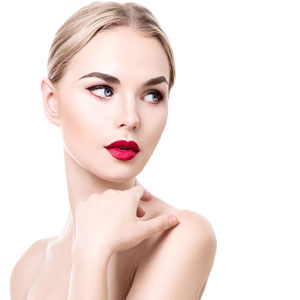
Conveniently located on Seven Mile Beach, Grand Cayman
UNDERSTANDING AGE-RELATED CHANGES IN HAIR: HORMONAL SHIFTS, MELANIN REDUCTION, AND FOLLICLE FUNCTION

As individuals age, several changes occur in their hair. These age-related changes occur due to shifts in hormone levels, decreased melanin production, and changes in hair follicle function. Gray hair is a prominent characteristic, resulting from a decrease in melanin production, which causes the hair to lose its pigment and appear gray or white. Moreover, the hair may become thinner and more brittle as the hair follicles shrink and produce less hair. Furthermore, the rate of hair growth may also slow down, leading to slower regrowth after shedding. In addition, hormonal changes can lead to hair loss or thinning, particularly in men due to increased levels of dihydrotestosterone (DHT), a derivative of testosterone. Overall, these age-related changes in hair can affect its texture, color, density, and growth patterns.
CAUSES OF HAIR LOSS
Aside from aging, hair loss (medically known as alopecia) can result from other factors, including:
- Diet: Crash diets, extreme weight loss, or poor dietary habits can disrupt the body’s nutritional balance and affect hair health.
- Genetics (Androgenetic alopecia): Hereditary hair loss, also known as male-pattern or female-pattern baldness, is the most common cause of hair loss and is influenced by genetic factors.
- Hair care practices: Overuse of styling tools (e.g., hair straighteners, curling irons), harsh chemical treatments (e.g., bleaching, perming), tight hairstyles (e.g., ponytails, braids), and frequent manipulation of the hair can cause damage to the hair shaft and lead to breakage or hair loss.
- Hormonal changes: Hormonal imbalances, such as those associated with pregnancy, childbirth, menopause, or thyroid disorders, can contribute to hair loss by affecting the function of the hair follicles.
- Medical conditions: Certain medical conditions can cause or contribute to hair loss, including autoimmune diseases (e.g., alopecia areata), scalp infections (e.g., ringworm), and chronic illnesses (e.g., lupus).
- Medications and treatments: Chemotherapy, radiation therapy, anticoagulants, antidepressants, beta-blockers, and oral contraceptives can lead to hair loss as a side effect.
- Nutritional deficiencies: Inadequate intake of essential nutrients, such as iron, protein, vitamins (e.g., B vitamins, vitamin D), and minerals (e.g., zinc), can impact hair growth and contribute to hair loss.
- Stress and emotional factors: Emotional stress, traumatic events, or significant life changes can trigger a type of hair loss called telogen effluvium, where hair prematurely enters the resting phase of the hair growth cycle and sheds more than usual.
Understanding the underlying causes of hair loss is essential for determining the most appropriate treatment approach. Nurse Kelly emphasizes the importance of conducting a thorough evaluation to identify any contributing factors and guide personalized treatment recommendations tailored to each patient’s specific needs. A comprehensive assessment by Nurse Kelly and Dr. Christoffersen allows for a targeted approach to addressing hair loss and optimizing treatment outcomes.
Mesotherapy
Mesotherapy with Pluryal involves injecting a customized blend of vitamins, minerals, amino acids, and other nutrients directly into the scalp. These injections stimulate hair follicles, improve blood circulation, and promote hair growth. The nutrient-rich solution nourishes the scalp, strengthens hair follicles, and encourages the growth of thicker, healthier hair.
Microneedling
Microneedling, also known as collagen induction therapy, uses a device with fine needles known as Dermapen to create tiny punctures in the scalp. These micro-injuries stimulate the body’s natural healing response, increasing collagen production and promoting the absorption of topical treatments. When combined with specialized serums or growth factors, microneedling can enhance the delivery of nutrients to the hair follicles, improve scalp health, and stimulate hair growth.
Platelet-Rich Plasma (PRP)
PRP therapy involves extracting a small amount of the patient’s blood, processing it to isolate the platelet-rich plasma, and injecting it into the scalp. Platelets contain growth factors that play a key role in tissue repair and regeneration. When injected into the scalp, PRP stimulates hair follicles, prolongs the growth phase of the hair cycle, and promotes new hair growth. PRP also has anti-inflammatory properties that can help improve scalp health and reduce hair loss due to inflammatory conditions such as alopecia areata.
Each of these treatments offers unique benefits for treating hair loss, and they can be used alone or in combination to customize treatment plans based on individual needs and goals. Nurse Kelly can evaluate the patient’s specific condition and recommend the most appropriate combination of mesotherapy, microneedling, and PRP therapy to address underlying factors contributing to hair loss and promote scalp health. By tailoring treatment to each patient’s unique needs, Nurse Kelly aims to help her patients achieve thicker, fuller hair and improve their overall confidence and well-being.
PERSONALIZED MEDICAL ASSESSMENTS AND TREATMENT PLANS
 Nurse Kelly can create personalized medical assessments and treatment plans for hair loss by following a systematic approach that takes into account the individual needs and characteristics of each patient. Nurse Kelly begins by conducting a thorough review of the patient’s medical history, including any past or current medical conditions, medications, surgeries, and family history of hair loss. This helps identify potential underlying causes of hair loss and tailor treatment accordingly.
Nurse Kelly can create personalized medical assessments and treatment plans for hair loss by following a systematic approach that takes into account the individual needs and characteristics of each patient. Nurse Kelly begins by conducting a thorough review of the patient’s medical history, including any past or current medical conditions, medications, surgeries, and family history of hair loss. This helps identify potential underlying causes of hair loss and tailor treatment accordingly.
After discussing the medical history, Nurse Kelly performs a detailed examination of the patient’s scalp and hair to assess the extent of hair loss, hair density, scalp health, and any signs of inflammation or infection. This evaluation helps determine the most appropriate treatment options and interventions for the patient’s specific condition. Depending on the extent and severity of hair loss, Nurse Kelly may recommend additional diagnostic tests to evaluate the underlying causes of hair loss further. These tests may include blood tests to assess hormone levels, thyroid function, iron levels, and other relevant biomarkers associated with hair health.
Based on the findings from the medical assessment, scalp examination, and diagnostic tests, Nurse Kelly in collaboration with Dr. Christoffersen develops a personalised treatment plan tailored to the patient’s individual needs and goals. This plan may include a combination of medical treatments, lifestyle modifications, and supportive therapies aimed at addressing the underlying causes of hair loss and promoting hair growth.
Depending on the cause of hair loss and the patient’s preferences, Nurse Kelly may offer scalp treatments such as mesotherapy, microneedling, or platelet-rich plasma (PRP) therapy to improve scalp circulation, nourish hair follicles, and promote hair growth. These treatments can be customized based on the patient’s specific needs.
LINKS TO TREATMENT OPTIONS

MESOTHERAPY |
Mesotherapy revitalizes the skin, promoting hydration, firmness, and a radiant complexion. |

MICRONEEDLING |
Microneedling stimulates growth of collagen, leaving you with youthful-looking skin! |

PRP |
PRP is a concentrated solution of platelets derived from the patient’s own blood, used for regenerative purposes in aesthetic injections. |
TREATMENT OPTIONS FOR ACNE & BLEMISHES
CHEMICAL PEELS
They are a chemical solution applied to the skin which causes controlled damage to the top skin layers. Chemical peels, such as ZO Peel, stimulate the body’s natural healing process – new skin cells form in the treated area and the old and dead skin cells slough off. This prompts the skin to exfoliate and peel off. Depending on the skin condition, the chemical solution to be used can vary – alpha hydroxy acids (AHAs), beta hydroxy acids (BHAs), or trichloroacetic acid (TCA). These acids can help address acne as well as blemishes by stimulating collagen production, unclogging skin pores, reducing inflammation, and dissolving dead skin cells in the treated area.
GENESIS SKIN TREATMENT
Genesis skin, treatment utilizes non-invasive laser technology, specifically the Nd:YAG laser. With this state-of-the-art treatment, it can target the deeper skin layers without causing damage to the surrounding tissue. The laser energy heats different skin layers in a controlled manner, which in turn stimulates collagen production. With increased collagen, enlarged pores shrink and skin inflammation is reduced. Moreover, the laser energy may also target blood vessels to reduce redness associated with acne.
MESOTHERAPY
Mesotherapy treatment with Pluryal, involves the injection of a customized cocktail of vitamins, minerals, amino acids, and other therapeutic ingredients directly into the middle layer of the skin known as the mesoderm. These ingredients stimulate collagen production and promote skin healing. Over time, the appearance and health of the skin is improved.
MICRODERMABRASION
Microdermabrasion with Dermasweep, makes use of a handheld device with a diamond-tipped or crystal-tipped abrasive surface to gently exfoliate the skin. During the treatment, the device is moved across the target area. This process helps to unclog pores and promote cell turnover (formation of new skin cells). As a result, the appearance of visible skin concerns are reduced. In addition, the treatment can also enhance the penetration of skincare products – this means better absorption of substances or ingredients which leads to increased efficacy.
MICRONEEDLING
Microneedling treatment uses Dermapen, a device with fine needles, to create controlled micro-injuries (very tiny wounds) on the skin’s surface. As a result, the body responds by activating the natural wound healing process (skin regeneration and remodeling). In addition, collagen production is increased and new, healthy skin cells form in the treated area. This process significantly reduces acne and blemishes and improves overall skin health.
ZO FACIAL TREATMENTS
ZO facial treatments, utilize a combination of advanced skincare techniques and medical-grade products. These treatments typically involve a series of steps, including cleansing, exfoliation, extraction (if necessary), and application of targeted serums or masks. This combination unclogs skin pores, reduces inflammation, and promotes skin renewal (new, healthy skin cells form in the treated area).
Fast Facts
Who’s it for?
Coolsculpting is indicated for patients with stubborn fat, cellulite, and double chin.
Similar products:
CoolTech, Clatuu.
Celebs who swear by it:
Jennifer Aniston, Kris Jenner, Mariah Carey and Kim Kardashian
Question & Answer
Are there discomforts associated with Coolsculpting?
During the procedure, you may feel sensations of deep pulling, tugging, and pinching as the applicator passes over the treated area. You may also experience cramping, stinging, or tingling sensations. As the freezing applicator delivers controlled cooling, the treated area will temporarily become numb, thus reducing any discomfort.
Will the fat come back after Coolsculpting?
The treatment permanently eliminates the fat cells in the treated area. However, you will still need to maintain a healthy weight after the treatment because significant weight gain can compromise your results.
How long does it take to see Coolsculpting results?
You may begin to notice the results 1 to 3 months after the treatment. However, you will need to wait 4 months to see the final results.
How many Coolsculpting treatments will I need?
The treatment permanently destroys approximately 25% of the exposed fat cells in the treated area but this is enough to produce significant body contouring improvement. While you may benefit from one treatment, you may need two treatment sessions to achieve the best results. The number of treatments you will need will depend on the amount of fat in the target area.
Are there any side effects associated with Coolsculpting?
After the treatment, you may experience mild discomforts such as redness, bruising, numbness, or swelling. You may apply ice packs to the treated area to minimize any discomfort. After 1 to 2 weeks, these discomforts should resolve completely.
Will I lose weight with Coolsculpting?
It is important to keep in mind that the treatment is not a weight loss solution. While Coolsculpting contours the treated area by delivering controlled and precise cooling to the fat cells, you will still need to commit to a healthy lifestyle after the treatment because significant weight gain can compromise your results.
Who are the ideal candidates for Coolsculpting?
The treatment is compatible with all skin types and tones. As long as you are in good overall physical and mental health, the treatment is right for you. However, you are not an ideal candidate for the treatment if you have the following:
- A significant amount of fat in a body area
- Cold agglutinin disease (a red blood cell disorder)
- Cryoglobulinemia (the presence of abnormal proteins in the blood)
- Paroxysmal cold hemoglobulinuria (a rare blood disorder that attacks red blood cells)
- Unrealistic expectations
How much does Coolsculpting cost?
The total cost will depend on the following factors:
- The practitioner’s fee
- The fee of the clinic or medical facility
- The number of treatment sessions required
- The body area needing treatment
The treatment is cosmetic in nature. This means that the cost of the treatment may not be covered by your insurance. Before the procedure, it is best to consult with your health insurance provider for more information.
References
- Oh, C. H., Shim, J. S., Bae, K. I., & Chang, J. H. (2020). Clinical application of cryolipolysis in Asian patients for subcutaneous fat reduction and body contouring. Archives of plastic surgery, 47(1), 62–69. https://doi.org/10.5999/aps.2019.01305. Retrieved from https://www.ncbi.nlm.nih.gov/pmc/articles/PMC6976754/.
- McKeown, D. J., & Payne, J. (2021). Significant improvement in body contour with multiple cycles of CoolSculpting: Results of a prospective study. Dermatologic therapy, 34(2), e14850. https://doi.org/10.1111/dth.14850. Retrieved from https://www.ncbi.nlm.nih.gov/pmc/articles/PMC8047906/.
- Lim, T., Ding, S. W., Chua, C. H., & Moey, H. X. (2021). Enhancing the Appearance of the “Six-Pack” Muscles Using Cryolipolysis: A Safe and Effective Method. Plastic and reconstructive surgery, 148(4), 775–779. https://doi.org/10.1097/PRS.0000000000008320. Retrieved from https://pubmed.ncbi.nlm.nih.gov/34550933/.
- Putra, I. B., Jusuf, N. K., & Dewi, N. K. (2019). Utilisation of Cryolipolysis among Asians: A Review on Efficacy and Safety. Open access Macedonian journal of medical sciences, 7(9), 1548–1554. Retrieved from https://www.ncbi.nlm.nih.gov/pmc/articles/PMC6542401/.
- Few, J., Saltz, R., Beaty, M., Kelly, M., Movassaghi, K., Marcus, K. A., Sieber, D., Burns, A. J., & Sangha, S. (2020). Cryolipolysis: Clinical Best Practices and Other Nonclinical Considerations. Aesthetic surgery journal. Open forum, 2(2), ojaa010. https://doi.org/10.1093/asjof/ojaa010. Retrieved from https://www.ncbi.nlm.nih.gov/pmc/articles/PMC7671251/.
- Naeimi, M. et al. (2019) Treatment by cryolipolysis with radio-frequency and ultrasound cavitation combination is no more effective in improving indices of adiposity than radio-frequency and ultrasound cavitation alone, Translational Metabolic Syndrome Research. Elsevier. Retrieved from https://www.sciencedirect.com/science/article/pii/S2588930318300136.
- Suh, D. H., Park, J. H., Jung, H. K., Lee, S. J., Kim, H. J., & Ryu, H. J. (2018). Cryolipolysis for submental fat reduction in Asians. Journal of cosmetic and laser therapy : official publication of the European Society for Laser Dermatology, 20(1), 24–27. https://doi.org/10.1080/14764172.2017.1368564. Retrieved from https://pubmed.ncbi.nlm.nih.gov/28850270/.
- Rodopoulou, S., Gavala, M. I., & Keramidas, E. (2020). Three-dimensional Cryolipolysis for Submental and Lateral Neck Fat Reduction. Plastic and reconstructive surgery. Global open, 8(4), e2789. https://doi.org/10.1097/GOX.0000000000002789. Retrieved from https://pubmed.ncbi.nlm.nih.gov/32440449/.
- de Gusmão, P. R., Canella, C., de Gusmão, B. R., Filippo, A. A., & Filippo, G. R. (2020). Cryolipolysis for local fat reduction in adults from Brazil: A single-arm intervention study. Journal of cosmetic dermatology, 19(11), 2898–2905. https://doi.org/10.1111/jocd.13389. Retrieved from https://pubmed.ncbi.nlm.nih.gov/32281283/.




 HOW TO LOOK YOUR BEST
HOW TO LOOK YOUR BEST